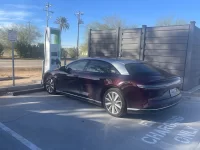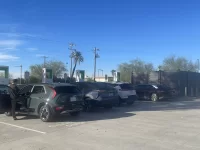Road Trip Update, with apologies to
@DeaneG for co-opting his thread with my moaning about EA -
So the drive back from Phoenix AZ to San Diego CA went a lot, lot better. I wasn’t intending to stop at the benighted EA DCFC at Dateland AZ, the location that gave me such a headache a few nights previous, I was intending to stop either in Yuma AZ or El Centro CA. In any case, as I was approaching the Dateland exit on the 8, I remembered that I never got to pick up my “dateshake”, because the travel centre café had decided to shutter their doors very early that dark and rainy evening. So I pulled off the freeway.
Approaching the charging station, I noticed that three of the four stalls were occupied, and all appeared to be charging normally. Hooray! Until I pulled up the one available stall and noticed that not only was the charger screen very dimly lit, but there were several lines of ominous looking MS-DOS(?) code scrolling through. I dialed EA Customer Care to request a reboot, got promptly put on IGNORED, when presently a BMW SUV-EV-type-thing vacated a stall at the end. I dove for that stall right away and started charging.
Charging from 50% to 95% appeared normal, and took about 45 minutes. Not surprising really since I began my charging session at an already high state of charge. After my experience the other night I wasn’t about to complain.
On the remaining 240 mile drive home, I maintained a slightly higher cruise speed overall, at 85 mph. I shot up to 111 mph on some stretches and on one occasion stayed at 100 mph for about ten minutes. Then, I chickened out because of cops possibly prowling the area, and because my charge level started dropping quite dramatically. It’s astonishing to watch the rate at which your battery level drops when you sustain very high freeway speeds.
On the windy stretch westbound through the Cajon Pass, which separates the desert from San Diego’s hilly back country, I got into a somewhat ill-advised drag race with a black Toyota T100 truck of all things! The thing about the Lucid is that it’s so well planted on the road, its driving dynamics so confidence inspiring, that it gives genuinely mediocre middle aged drivers like me a false sense of driving proficiency. So there I was taking bends with a posted speed limit of 45 mph (yellow, safety related speed llimit sign), at close to 100 mph! Very foolish of me to have been baited, and I don’t recommend this kind of behaviour at all. But, in that moment it was too late. I’d taken up the challenge and I charged ahead, determined to stay ahead of this jerk in the black Toyota truck.
Much to my surprise, the T100, while never passing me, was never far behind, even at speeds between 90 to 100 mph. He must have been really working to keep up with me, and he must have known the road really well. I, on the other hand, wasn’t so familiar.
Anyway, shooting out at the western end of Cajon Pass, and starting to worry about my decreasing range, I pulled over into the right lane and let the truck pass. He quickly pulled away into the distance and rounded a bend, and fell out of sight. Rounding that same bend several seconds later, lo, what do I see - CHP with blue and red flashing lights turning, had pulled the T100 over! I leaned heavily and heartily into my horn as I passed them by.
For the rest of the drive home, I slowed down considerably, from over 85 mph to 75 mph. Lucid navigation had predicted that from 95%, I would arrive home at 26%. But I had had several stretches of shall I say, really spirited driving, and it looked like I would arrive home with considerably less charge than that. My aim was to arrive home with no less than 20%. That way the car wouldn’t be sitting in my garage at a low state of charge (less than 20%), waiting for several hours until midnight, before charging.
Based on this 720 mile roundtrip road trip, I’ve stumbled upon a personal rule of thumb. It seems to work, and while I’d never claim to be the brightest star in the firmament, I’m surprised that I hadn’t noticed it before - Assuming a 100% charge at the start, take your average mile/kWh reading and multiply by 100. That’ll give you your range available. For example, 2.9 miles/kWh will give you 290 miles. 3.1 miles/kWh will give you 310 miles, etc.
Based on this rule of thumb, if I’d wanted to drive from San Diego to Phoenix without stopping to charge, a distance of 360 miles, and been willing to arrive in Phoenix jittery as a cat in a roomful of stomping elephants, I would have had to do whatever it took to achieve an average efficiency of 3.6 miles/kWh. Namely, slow the heck down. As many of us on here know, factors like topography, weather, wind, outside air temperature, road conditions, etc have some bearing on efficiency, but none more so than speed.
Lucid Air GT. 19 inch rims.


